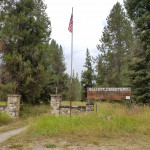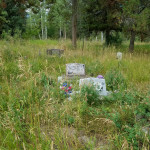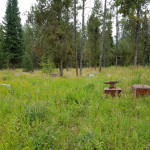Located about a half-mile up Teton Pass, the Elliott Cemetery is located on the old John Elliott homestead. John lost two young sons to the 1902 diphtheria outbreak, and buried them on a bench behind the homestead. The current Elliott Cemetery is near the location of these two graves. John worked as a day laborer, and his wife Jennie stayed home to raise their five sons. After the deaths of their sons, the Elliott family donated their homestead for use as a cemetery and relocated to Alta, Wyoming. In Alta, John worked as a traction engine engineer. The Elliott Cemetery was established early, so there are several early notable homesteaders and ranchers who are buried there. As more space was needed, several more acres were donated for expansions from the Schofield, Yokel and Huidekoper families.
Selar Cheney (1880-1951)
Selar Cheney and his wife Mary Alice Wilson (daughter of Sylvester Wilson) first arrived in Jackson Hole with the extended Wilson family in 1889, the first families to enter the valley in wagons. They cut the first path that would come to be Teton Pass, and are responsible for developing much of the valley’s community infrastructure. The first school, church and medicine can be credited to these first families. Selar Cheney was a well-known rancher, and a member of the Wyoming Stock Growers Association. He was also popular at local dances for his ability to play the fiddle and dance. In April 1902, the Cheney Post Office replaced the South Park Post Office and the area became known as Cheney. In 1917 the Cheney Post Office was closed, and mail came from Jackson. The area became known as South Park again. For more information on the Wilson families, please visit: https://historyjackson.wpengine.com/first-families-of-jackson-hole/
William J. Grant, Sr. (1953-1923)
William Grant homesteaded south of the Sawmill Ponds on Moose-Wilson Road in the 1920s. Grant used the available water from the ponds to irrigate over 90 acres of his 160-acre homestead. He raised hay and clover, and managed a large garden. He also worked as a blacksmith, one of six in the valley in 1920. Grant opened the first post office in the area, naming it Moose, in April 1923. Prior to this, the area was referred to as Menor’s Ferry, due to the ferry crossing that Bill Menor had operated. The Moose Post Office opened in Grant’s store, another first for the small area. The Grant homestead later became part of the Circle H and R Lazy S dude ranches.
James “Jimmy” H. Manges (1882-1960)
In 1911, Jimmy Manges became one of the first homesteaders on the west bank of the Snake River. Just south of Jenny Lake, the homestead would later be part of some of the most sought-after land in Jackson Hole. Jenny Lake would become the most popular destination spot for visitors in Grand Teton National Park. Jimmy sold most of his 160-acre homestead to Chester Goss, for the development of the Elbo Ranch. Keeping 4.9 acres for himself, Jimmy accidentally found himself in the dude business. The X Quarter Circle X dude ranch was exceptional for its rustic qualities. Early families built their own cabins, often out of whatever materials were available, while others camped in tents. None had electricity or running water, and the families were responsible for their upkeep. In the 1960s, Manges died and the property became part of Grand Teton National Park. Today his homestead is marked with his cabin, notable for being the first two-story log structure in the valley.
Please be respectful of all posted signage and other visitors.



